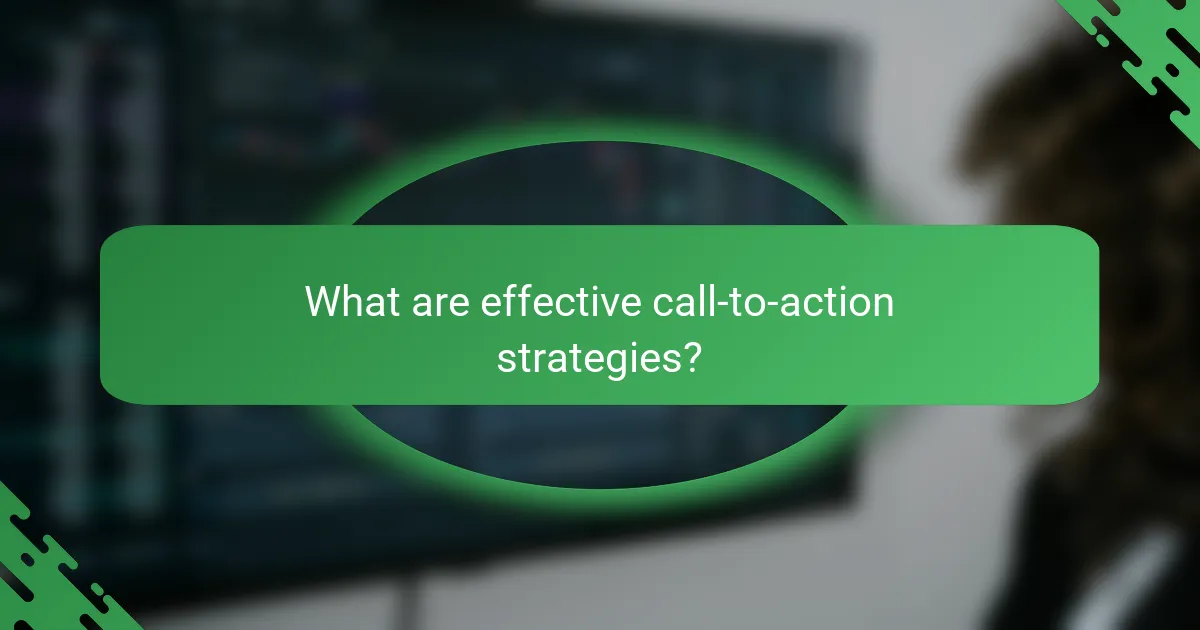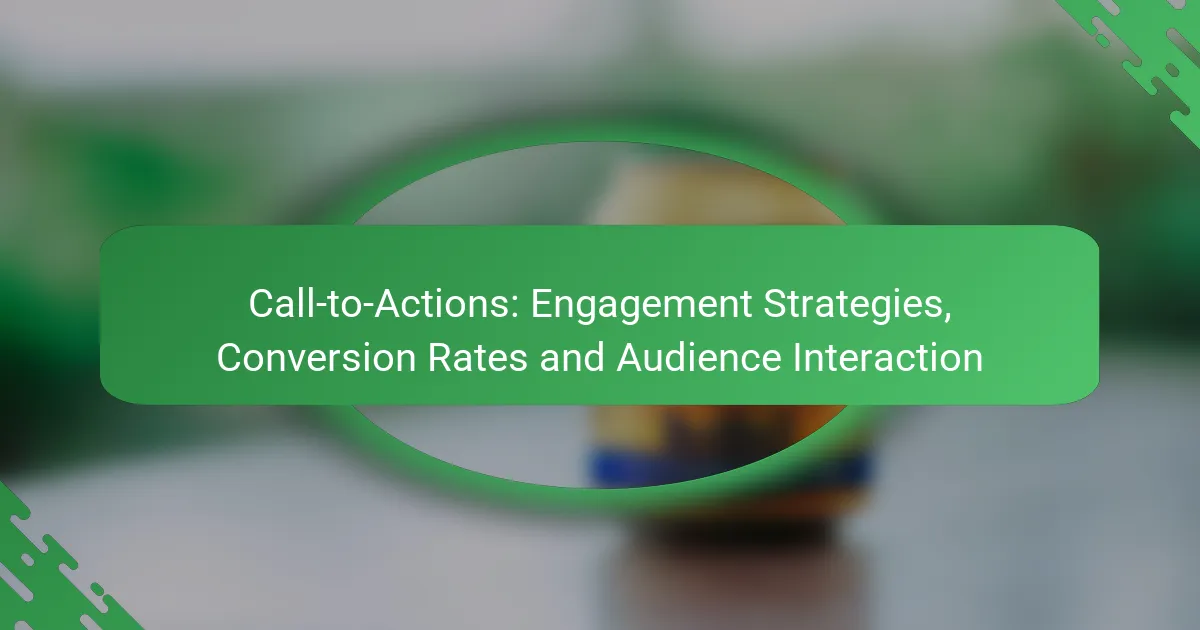Call-to-actions (CTAs) play a crucial role in boosting user engagement by encouraging immediate responses from visitors. By employing clear messaging and a sense of urgency, effective CTAs guide audiences toward desired actions, such as signing up for newsletters or making purchases, ultimately enhancing conversion rates and overall satisfaction.

How can call-to-actions improve engagement in the UK?
Call-to-actions (CTAs) can significantly enhance user engagement in the UK by prompting immediate responses from visitors. Effective CTAs guide users toward desired actions, such as signing up for newsletters or making purchases, thereby increasing interaction and overall satisfaction.
Increased user interaction
Well-crafted CTAs encourage users to engage more with your content. For example, using phrases like “Join our community” or “Get your free trial” can prompt users to take action rather than passively consuming information. This interaction can lead to longer time spent on your site and more pages viewed.
To maximize interaction, consider placing CTAs strategically throughout your website, such as at the end of blog posts or in pop-up forms. Testing different placements and wording can help identify what resonates best with your audience.
Higher conversion rates
CTAs are crucial for driving conversions, which refer to the percentage of visitors who complete a desired action. In the UK, effective CTAs can boost conversion rates by several percentage points, depending on their design and placement. For instance, a clear, contrasting button can attract attention and encourage clicks.
To enhance conversion rates, use action-oriented language and create a sense of urgency, such as “Limited time offer” or “Sign up now.” Regularly analyzing conversion metrics can help refine your approach and improve outcomes over time.
Enhanced brand loyalty
Engaging CTAs can foster brand loyalty by creating a sense of community and encouraging repeat interactions. When users feel connected to a brand through effective calls-to-action, they are more likely to return and recommend the brand to others. For example, inviting users to follow your social media channels can strengthen this connection.
To build loyalty, ensure your CTAs reflect your brand’s voice and values. Consistency in messaging and follow-up communication can reinforce positive experiences and encourage long-term relationships with customers.

What are effective call-to-action strategies?
Effective call-to-action (CTA) strategies are designed to prompt immediate responses from your audience, guiding them towards desired actions. These strategies leverage clear messaging, urgency, and personalization to enhance engagement and conversion rates.
Clear and concise messaging
Clear and concise messaging is crucial for effective CTAs. Use simple language that directly communicates what action you want the audience to take, such as “Sign Up Now” or “Get Your Free Trial.” Avoid jargon and ensure the message is easy to understand at a glance.
Consider the placement of your CTA as well. It should be prominently displayed on your webpage, ideally above the fold, so users can see it without scrolling. A/B testing different phrases can help determine which messages resonate best with your audience.
Urgency and scarcity tactics
Urgency and scarcity tactics create a sense of immediacy that can significantly boost conversion rates. Phrases like “Limited Time Offer” or “Only 5 Spots Left” encourage users to act quickly to avoid missing out. This psychological trigger can be particularly effective in driving sales or sign-ups.
To implement these tactics, consider using countdown timers or highlighting limited availability in your messaging. Just be cautious not to overuse these strategies, as they can lead to skepticism if customers feel manipulated.
Personalization techniques
Personalization techniques tailor CTAs to individual user preferences and behaviors, making them more relevant and engaging. For instance, using a visitor’s name or suggesting products based on past purchases can enhance the likelihood of interaction.
Utilize data analytics to segment your audience and create targeted CTAs. This could involve adjusting the messaging based on demographics or user behavior, ensuring each user receives a unique experience that resonates with them. Remember to test different personalized approaches to find what works best for your audience.

What metrics measure call-to-action effectiveness?
To evaluate call-to-action (CTA) effectiveness, key metrics include click-through rates, conversion rates, and engagement metrics. These indicators help determine how well CTAs drive user actions and overall campaign success.
Click-through rates
Click-through rate (CTR) measures the percentage of users who click on a CTA compared to the total number of users who view it. A higher CTR indicates that the CTA is compelling and relevant to the audience. Generally, a good CTR ranges from 2% to 5%, but this can vary based on industry and context.
To improve CTR, ensure that the CTA is visually distinct, uses action-oriented language, and is placed strategically within the content. A/B testing different designs and wording can also help identify what resonates best with your audience.
Conversion rates
Conversion rate refers to the percentage of users who complete a desired action after clicking a CTA, such as making a purchase or signing up for a newsletter. Effective CTAs typically achieve conversion rates between 1% and 10%, depending on the offer and audience targeting.
To enhance conversion rates, focus on aligning the CTA with user intent and providing a clear value proposition. Simplifying the conversion process and minimizing distractions on the landing page can also lead to better results.
Engagement metrics
Engagement metrics assess how users interact with your content and CTAs beyond just clicks. This includes time spent on the page, bounce rates, and social shares. High engagement often correlates with higher conversion rates, as it indicates that users find the content valuable.
To boost engagement, create high-quality, relevant content that encourages users to explore further. Incorporating multimedia elements like videos or infographics can also enhance user interaction and keep visitors on the page longer.

How do different industries utilize call-to-actions?
Different industries leverage call-to-actions (CTAs) to drive engagement and conversions tailored to their specific audiences. Effective CTAs can significantly enhance user interaction and influence purchasing decisions across various sectors.
Retail sector examples
In the retail sector, CTAs often encourage immediate purchases or promotions. Common phrases include “Shop Now,” “Get 20% Off Today,” or “Limited Stock Available.” These prompts create urgency and entice customers to complete transactions quickly.
Retailers may also use CTAs for newsletter sign-ups, offering discounts in exchange for email addresses. This strategy builds a customer database for future marketing efforts.
Service industry applications
Service industries, such as healthcare or consulting, utilize CTAs to schedule appointments or consultations. Phrases like “Book Your Free Consultation” or “Schedule an Appointment” guide potential clients toward taking action. Clear and straightforward CTAs help reduce friction in the decision-making process.
Additionally, service providers often include CTAs for client testimonials or case studies, enhancing credibility and encouraging new clients to engage.
Non-profit engagement
Non-profit organizations employ CTAs to inspire donations and volunteer sign-ups. Phrases such as “Donate Now” or “Join Our Cause” are designed to evoke emotional responses and prompt immediate action. These CTAs often highlight the impact of contributions, making the ask more compelling.
Non-profits may also use CTAs for event registrations, encouraging community involvement. Clear instructions on how to participate can significantly boost engagement and support for their missions.

What are common mistakes in call-to-action design?
Common mistakes in call-to-action (CTA) design can significantly hinder user engagement and conversion rates. Key issues include unclear messaging, ineffective placement, and lack of optimization for mobile devices.
Overcomplicated language
Using overcomplicated language in CTAs can confuse potential customers and lead to lower engagement. Clear, concise wording is essential; phrases like “Get started now” or “Join us today” are straightforward and encourage action.
Avoid jargon or technical terms that may alienate your audience. Instead, focus on simple, actionable verbs that resonate with users and clearly communicate the desired action.
Poor placement on pages
Poor placement of CTAs can result in missed opportunities for conversions. Ideally, CTAs should be positioned where users naturally look, such as above the fold or at the end of engaging content.
Consider using multiple CTAs throughout a page, ensuring they are contextually relevant. For instance, a CTA after a product description can effectively prompt users to make a purchase.
Lack of mobile optimization
A lack of mobile optimization can severely limit the effectiveness of CTAs, especially as more users access websites via smartphones. Ensure that CTAs are easily clickable and visually appealing on smaller screens.
Test your CTAs on various devices to confirm they maintain functionality and visibility. A good rule of thumb is to make buttons at least 44 pixels in height and width to accommodate touch interactions comfortably.
